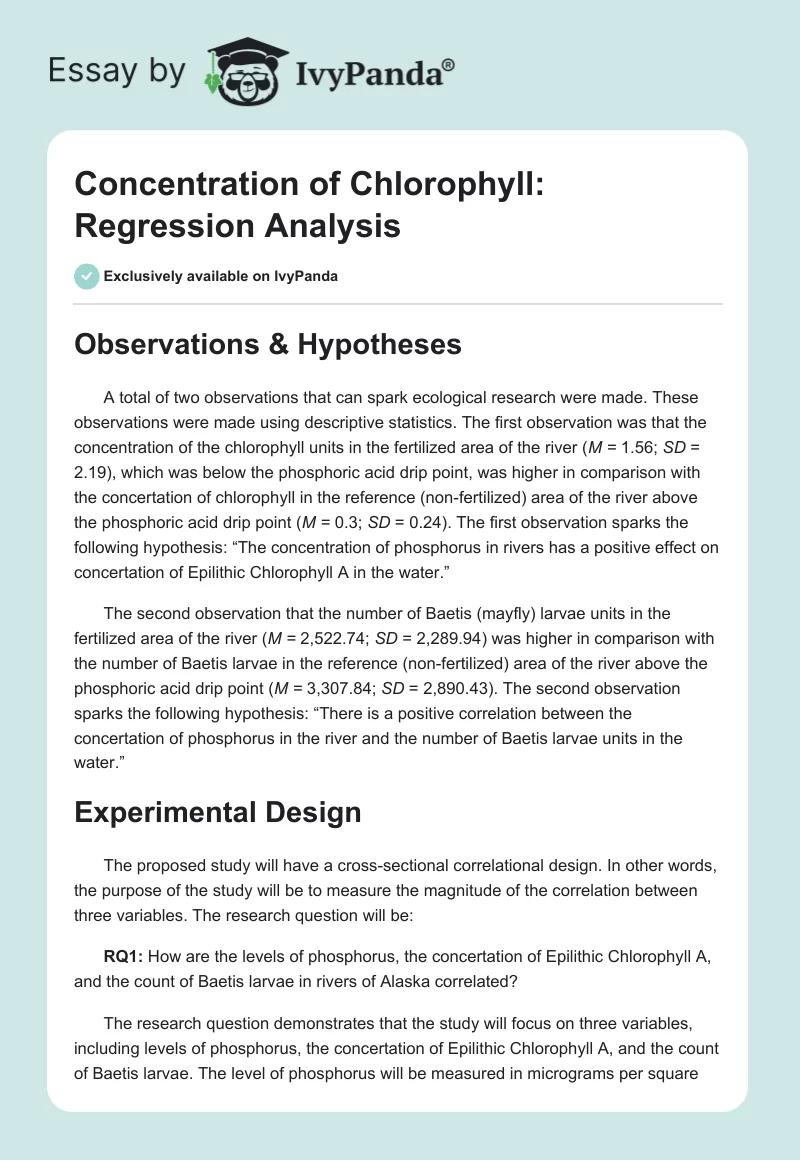Observations & Hypotheses
A total of two observations that can spark ecological research were made. These observations were made using descriptive statistics. The first observation was that the concentration of the chlorophyll units in the fertilized area of the river (M = 1.56; SD = 2.19), which was below the phosphoric acid drip point, was higher in comparison with the concertation of chlorophyll in the reference (non-fertilized) area of the river above the phosphoric acid drip point (M = 0.3; SD = 0.24). The first observation sparks the following hypothesis: “The concentration of phosphorus in rivers has a positive effect on concertation of Epilithic Chlorophyll A in the water.”
The second observation that the number of Baetis (mayfly) larvae units in the fertilized area of the river (M = 2,522.74; SD = 2,289.94) was higher in comparison with the number of Baetis larvae in the reference (non-fertilized) area of the river above the phosphoric acid drip point (M = 3,307.84; SD = 2,890.43). The second observation sparks the following hypothesis: “There is a positive correlation between the concertation of phosphorus in the river and the number of Baetis larvae units in the water.”
Experimental Design
The proposed study will have a cross-sectional correlational design. In other words, the purpose of the study will be to measure the magnitude of the correlation between three variables. The research question will be:
RQ1: How are the levels of phosphorus, the concertation of Epilithic Chlorophyll A, and the count of Baetis larvae in rivers of Alaska correlated?
The research question demonstrates that the study will focus on three variables, including levels of phosphorus, the concertation of Epilithic Chlorophyll A, and the count of Baetis larvae. The level of phosphorus will be measured in micrograms per square centimeter, the concertation of Epilithic Chlorophyll A will also be measured in micrograms per square centimeter, and the number of Baetis larvae will be measured will be measured in number per square centimeter. The measurements will be taken in different places in different rivers of Alaska, with at least 10 measurements of the variables in different places of every river. The hypotheses will be tested using regression analysis.
Visualization
One of the most efficient ways to visualize the data is to use descriptive statistics. Analysis of descriptive statistics is crucial for data analysis, as it serves two purposes. On the one hand, descriptive statistics helps the researcher understand the distribution of data and spot relationships between variables (McClaive et al. 2018). It helps to summarise data and present it in an easy-to-understand manner. Descriptive statistics can also be utilized to make predictions and develop models based on the data (McClaive et al. 2018). On the other hand, descriptive statistics can be used to compare different data sets and understand their differences (McClaive et al. 2018). The descriptive statistics provided in Table 1 below demonstrate that the mean concertation of chlorophyll in the fertilized area is around five time higher than that in the non-fertilized area. This can be explained by the fact that phosphorus allows faster reproduction of algae due to increased presence of non-organic feed.
Table 1. Descriptive statistics for Observation 1
Data can also be visualized using bar charts. Figure 1 below demonstrates that the mean count of Baetis larvae in the non-fertilized area was lower than that in the fertilized area. This can be explained by the fact that the increased presence of phosphorus increases the amount of algae in the river, which leads to an increased amount of feed for insects, such as Baetis, which increases their reproduction speed.
Reference
McClaive, J., Benson, G. & Sincich, D. (2018). Statistics for business and economics. London: Pearson.


